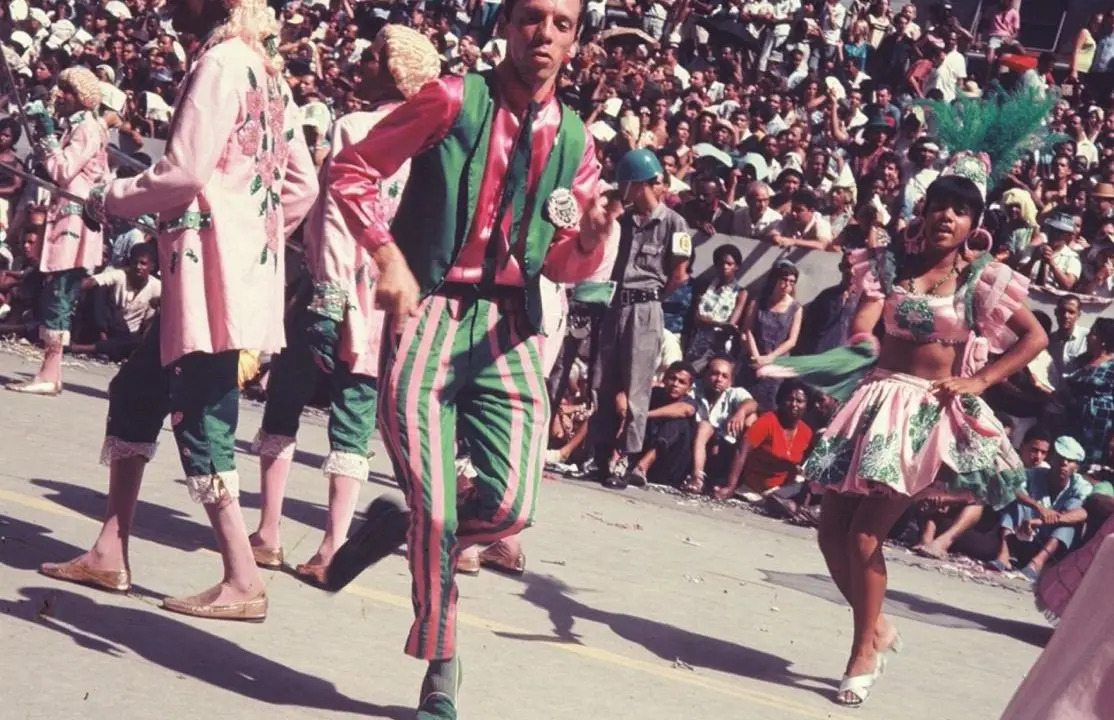The word “carnival” has its origins in Classical Latin, derived from “carnem” and “levare”, meaning “to abstain from, to remove meat.”
Brazilian Carnival is one of the largest and most important popular expressions in the world, spanning multiple artistic languages. Throughout history, it is possible to perceive the aesthetic influences that shape this cathartic manifestation: music, dance, the exuberance of colors, allegories, banners, sculptural objects, costumes, and sketches.
Several generations of artists from different movements have been drawn to the theme: from Debret to Rafa Bqueer, passing through Tarsila, Di Cavalcanti, Portinari, Heitor dos Prazeres, Carlos Vergara, Beatriz Milhazes, and Alair Gomes, among many others. Yet no figure personifies the intersection between art and carnival better than Hélio Oiticica (1937–1980).
In 1963, the Carioca artist ascended the Mangueira hill for the first time, guided by the Paraíba sculptor Jackson Ribeiro (1928–1997), who at the time was an assistant to Amilcar de Castro — the artist invited to create the allegories for Estação Primeira for the following year’s carnival. This encounter with the hill and samba radically influenced H.O.’s work.
“In Mangueira, in the life of the hill, I discovered my path,” Oiticica said in a 1970 interview with Norma Pereira Rêgo.
It was in 1965, at the collective exhibition Opinião 65 at MAM Rio, that he presented his Parangolés for the first time. On the day of the opening, already a member of Verde e Rosa, he arrived at the museum dressed as a samba performer, dancing and singing alongside part of the drum battery and other sambistas. When they were prohibited from entering, he and his “wing” moved to the gardens, where they performed and were applauded by the public.
In the summer of 2021, with a desire for retrospective reflection, alongside the exhibition Hélio Oiticica: Dance in My Experience at MAM Rio, we invited the carnavalesco Leandro Vieira to curate the museum’s programming in partnership with leading figures from the traditional school, presenting workshops, seminars, and performances led by masters of Estação Primeira over three months, highlighting their ancestral knowledge. “The idea was to occupy MAM with the knowledge intrinsic to the samba schools through a plural artistic dialogue with those who hold specific knowledge, often undervalued despite its grandeur,” recalls Leandro.
Vieira, now leading Imperatriz Leopoldinense, spoke with this column about the process of conceiving and constructing carnival performances:
“In my work, the narrative gives visual shape to an organized discourse intended to produce visuality. I present my artistic intentions as one raises a flag, which unfolds not only in allegories but also in the costumes that enable the carnival fiction for thousands of individuals,” he explains.
I asked if we could think of carnival as a kind of support for art:
“The fact is that my artistic production ended up translating an authorship intent to create painting through the collective performance of bodies in states of fantasy. When I think about the costume for the participant, I consider a performing body that allows visual signs to be on display. I treat my parades as a kind of gallery without walls, where painting, performance, and plastic intention pour forth, while spectators’ eyes try to grasp what was born to experience the ephemerality of the moment,” Vieira responds.
One of the main challenges is translating the ephemeral and ritualistic ecstasy performed on the Avenida to museum spaces.
According to curator and researcher Clarissa Diniz, the connections between “visual arts” and carnival in Brazil exist even when they are not explicitly named or perceived:
“Since carnival is an artistic experience grounded in social life, I see much of its political force in the work of artists whose production may not even be aesthetically ‘carnivalesque.’ I refer to the power of profanation in Brazilian art, its interest in the dynamics of opposites or contradiction, the strength of public space and the streets, the protagonism of bodies, and constructions based not only on narrative structures but also on rhythm and intensity. There is much carnival in the way we think about the production, circulation, and audiences of visual arts,” says Clarissa.
“I see carnival in political critique, but also in the carnivalesque humor that has made Brazil one of the world’s leading meme producers. In short… as a social, political, and aesthetic practice, carnival contains much of the formation of what, from various perspectives, we can today call ‘Brazilian visual arts.’ And I like to think that it goes far beyond a tropicalist aesthetic. Carnival is not a specific visuality; it is, above all, a mode, a way of being and existing, a world. And it is many worlds,” concludes the curator.
